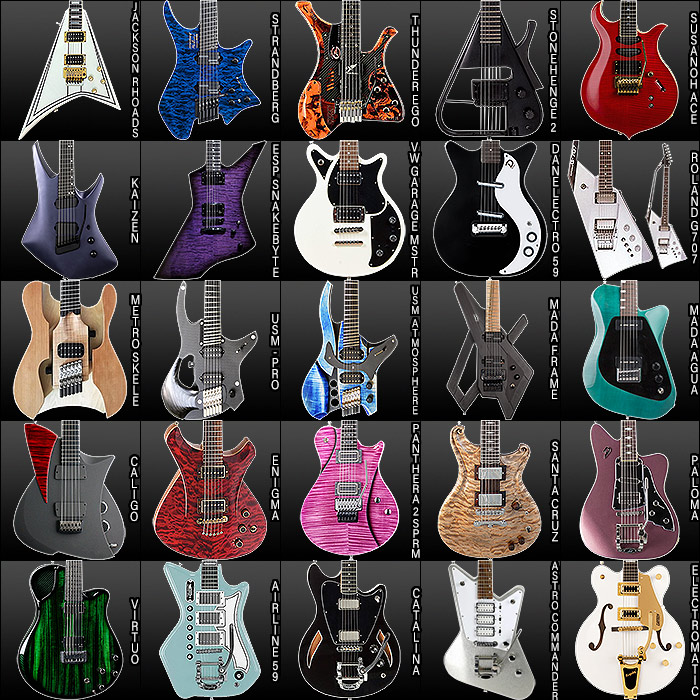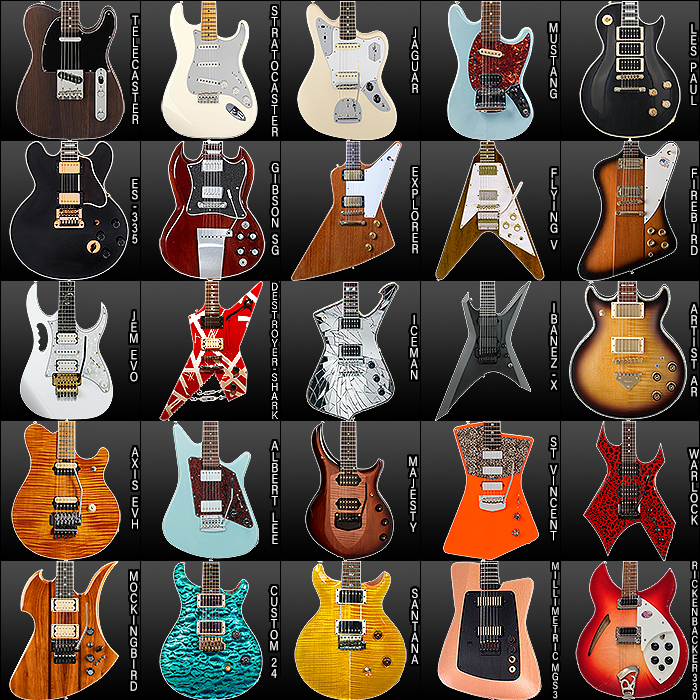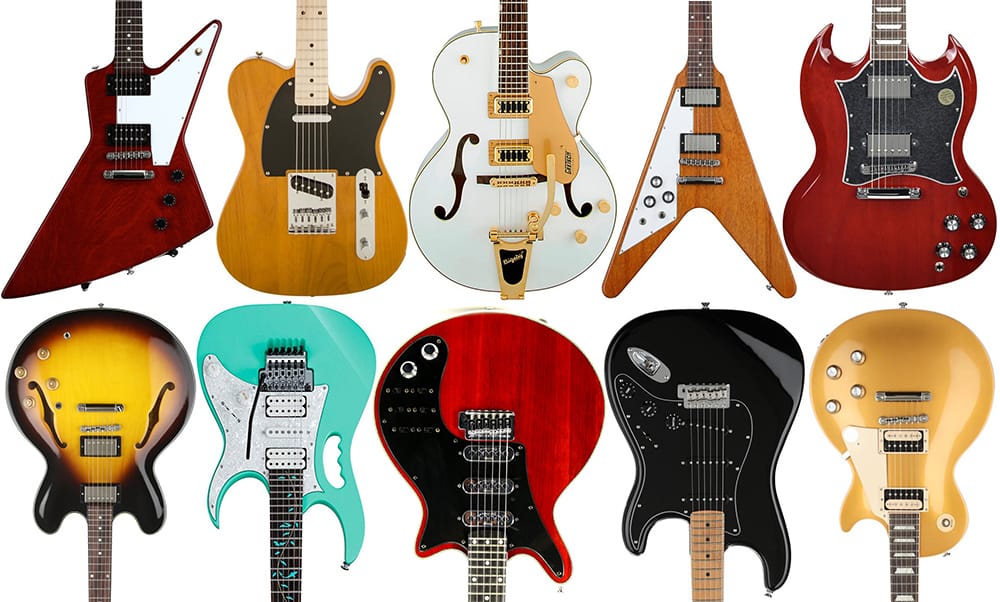Electric guitars acquired their shape through ergonomic and aesthetic considerations that evolved over decades. Iconic designs arose from the need for comfort, playability, and distinct visual appeal.
In the meantime, don't forget to unlock a world of unlimited sound with Amazon Music Unlimited, where over 100 million songs wait at your fingertips. Whether you're working, relaxing, or fueling your creativity, the right track is always just one tap away. Elevate every moment with music that moves you.
Electric guitars are not only instruments but also an emblem of the rock’n’roll era. Their shapes often reflect the vision and creativity of their designers, as well as the practical requirements of performers. With roots stretching back to the 1930s, electric guitars initially aimed to amplify sound for jazz bands without increasing the instrument’s size.
Designers like Leo Fender and Les Paul pioneered this evolution by introducing models that were easy to manufacture and visually striking, shaping the electric guitar’s role in modern music. These instruments had to be comfortable to hold, allow for easy access to high frets, and produce a clear, amplified sound. As rock music gained popularity, the aesthetic aspect of electric guitars became as significant as their sound, leading to the iconic shapes we recognize today.

Credit: www.guitarpedalx.com
The Origins Of The Electric Guitar
An instrument that has shaped the sound of modern music, the electric guitar, owes its form to a series of innovations and a fascinating evolution. It’s intriguing to dive into how this iconic instrument garnered its distinctive shape, which not only contributes to its aesthetic appeal but also to its sound and playability. Let’s explore the journey from its early predecessors to the sleek, electrified axes that command the stage today.
Early Predecessors And Innovations
The genesis of the electric guitar can be traced back to acoustic guitars and lutes used in classical music. Musicians sought greater volume and presence, which initially led to the creation of resonator guitars in the early 20th century. These early pioneers of amplification used metal cones to project the sound, delivering more punch, but it wasn’t until the application of electrical concepts that the real transformation began.
The Rise Of Electromagnetic Pickups
Electromagnetic pickups revolutionized guitar design by converting string vibrations into electrical signals. This innovation ushered in the era of the electric guitar. Players could now achieve volumes unheard of with traditional acoustic instruments. It was in the 1930s that George Beauchamp and Adolph Rickenbacker created the “Frying Pan,” the first electric lap steel guitar, furnished with these pickups and kicking off a new age in guitar manufacturing.
Key Influences On Electric Guitar Design
Iconic figures and musical styles have left an indelible mark on electric guitar shapes. Les Paul, a legendary guitarist, collaborated with Gibson to create a solid-body design that foregrounded sustain and resonance. Concurrently, Leo Fender’s work on the Telecaster and Stratocaster highlighted features like body contours and cutaways for comfort and access to higher frets, influencing the overall ergonomics of the instrument.
- Les Paul’s quest for a solid-body design that minimizes feedback
- Leo Fender’s innovation in streamlined shapes and functionality
- The pursuit of unique sounds from rock ‘n’ roll to jazz
Transition From Acoustic To Electric Shapes
The leap from hollow-bodied acoustics to solid-bodied electrics was not immediate. Early electric guitars retained acoustic properties, blending traditional craftsmanship with new technological advancements. Over time, it became clear that electric guitars did not require the same large bodies as acoustics because their sound relied on electronic amplification. Hence, designers concentrated on aspects like playability, stability, and style, which gave us the streamlined profiles and iconic silhouettes recognized on stages around the world today.

Credit: www.guitarpedalx.com
Iconic Electric Guitar Shapes And Their Creators
Iconic Electric Guitar Shapes and Their Creators have become more than just tools for musicians; they’ve evolved into enduring symbols of music genres and cultural epochs. Each shape telegraphs a different sonic signature, personality, and slice of history. The creation of these classic silhouettes was often the result of inventive collaboration, revolutionary design thinking, and a deep understanding of musicians’ needs. Let’s strum through some of the most groundbreaking moments in electric guitar design.
Fender Stratocaster And Leo Fender’s Vision
The Fender Stratocaster, with its sleek contours and double cutaway body, revolutionized guitar design when it debuted in 1954. Leo Fender’s vision for the Stratocaster was clear: to create a guitar that was comfortable, versatile, and aesthetically striking. The distinct body shape not only made the higher frets more accessible but also contributed to the instrument’s balance and playability. Attention was paid to the curves, fitting naturally against the player’s body, which made it an instant favorite among musicians of all genres.
Gibson Les Paul – The Collaboration With Les Paul
The Gibson Les Paul is a testament to the power of collaboration. Guitarist Les Paul partnered with Gibson in 1952 to design an electric guitar that offered the sustain and richness of a solid body instrument. This collaboration resulted in one of the most recognizable guitar profiles, characterized by a single cutaway body and a luxurious, carved maple top. The Les Paul not only provided a hearty, warm tone but also exuded an elegance that suited jazz and blues artists while being robust enough for rock and roll.
The Unique Contours Of The Gibson Sg
Unleashed in 1961, the Gibson SG boasts a radical design that stands out with its sharp double cutaways and slim, pointed horns. This design wasn’t simply for visual appeal; it allowed greater access to the upper frets, enabling more technical play. Its thinner body made of solid mahogany contributes to its lighter weight and resonant, biting tone—characteristics that have made it a favorite among many hard rock and metal players. The SG shows the continual evolution of electric guitar shapes, catering to the aggressive styles of modern music.
Other Notable Models And Their Design Philosophies
- Rickenbacker 300 Series: Renowned for its jangly sound that defined the British invasion of the 1960s. Its unique, crescent-shaped body and shimmering tone have continued to resonate with musicians.
- Ibanez RG Series: With its sharp, angular body and super-fast neck, the RG Series became synonymous with the shredders of the ’80s metal scene. Its design philosophy is firmly rooted in high-octane performance.
- PRS Custom 24: Paul Reed Smith Guitars brought a new level of artistry with the Custom 24. With its elegantly carved, figured maple top and bird inlays, PRS guitars are a blend of premium aesthetics and modern playability.
From revolutionary body shapes to groundbreaking hardware, these iconic guitars and their creators have indelibly shaped the music industry. Each model reflects the daring spirit, meticulous craft, and deep regard for the musician’s experience that continues to inspire guitarists to this day.
Functional, Aesthetic, And Cultural Factors
The iconic shapes of electric guitars we celebrate today didn’t emerge overnight. A confluence of functional, aesthetic, and cultural factors contributed to the evolution of this instrument’s silhouette. Starting from early prototypes to the modern axes that command the stage, every curve and contour has a story. Let’s dive into the compelling factors that have shaped the electric guitar over the decades, focusing on ergonomics, visual impact, and cultural significance.
Ergonomics And Player Comfort
The primary concern in the design of any musical instrument is usability—how comfortably it fits with the musician’s body. Electric guitars, renowned for their hourglass figures, were crafted keeping in mind not just the look, but also how they would feel when played for hours on end.
- Contours are strategically placed to accommodate the forearm and ribcage.
- The waist is indented to help the instrument rest easily on a player’s lap.
- Weight distribution ensures a balanced feel, whether standing or sitting.
- Neck profiles and fretboard radius are designed for ease of playability across various hand sizes and playing styles.
All these elements combined create an instrument that feels like an extension of the musician’s own body, facilitating a seamless play experience.
Aesthetic Appeal And Visual Impact
Beyond function, the shape of an electric guitar must captivate and inspire. With their sleek lines and eye-catching forms, these instruments are designed to be as visually striking as they are sonically powerful.
- Curves and angles contribute to a guitar’s distinctive identity.
- Finish and color play a vital role in enhancing its visual allure.
- The headstock’s shape can become a brand’s iconic signature.
- Artistic inlays and custom hardware add unique decorative touches.
These design decisions craft a visual language that complements the guitarist’s image and stage presence, creating an unforgettable impact.
Cultural And Genre Associations
Electric guitars have become synonymous with certain music genres and cultural movements. The visual identity of an electric guitar can often suggest the type of music it’s meant to play or the ethos it represents.
- The solid-bodied, sharp-angled shapes are often associated with rock and metal.
- Smooth, rounded designs echo the sophistication of jazz and blues.
- Decorative features and flamboyant colors match the exuberance of glam and psychedelic rock.
- Futuristic shapes align with the progressive and experimental nature of modern genres.
By embracing the visual cues of their genre, these guitars cement their place in the cultural lexicon, becoming emblems of their time.
Evolution Of Shapes In Response To Music Trends
The transformation of electric guitar shapes over time mimics the progression of music itself. As new genres emerge and artists seek fresh sounds, guitar designs adapt to meet these changing demands.
- The rise of rock ‘n’ roll saw the creation of iconic, rebellious designs.
- Advances in technology allowed for new materials and construction methods, leading to more radical shapes.
- As musicians pushed sonic boundaries, their instruments reflected this innovation with avant-garde aesthetics.
- Adapting to the ergonomic needs of high-speed playing, designs became sleeker and more streamlined.
The dynamic history of music is embodied in the evolution of the electric guitar, as it adapts continuously to set the stage for the future.
Technological Advancements And Modern Designs
Exploring the evolution of electric guitars reveals a fusion of technical innovation and cutting-edge aesthetics. Technological advancements and modern designs are not just facets of contemporary living but have been pivotal in shaping the iconic silhouettes of electric guitars. These instruments didn’t merely arise from functionality but from a daring dance with materials, trends, and cultural influences, forging new paths in sound and style.
Innovations In Materials And Construction Techniques
The journey of electric guitar design is marked by significant experimentation with materials and construction techniques. Early developers of the electric guitar, like Les Paul and Leo Fender, pushed the boundaries of what was physically and sonically possible. With the invention of amplification, the need for hollow bodies became obsolete, allowing for solid-body guitars that reduced feedback and increased sustain.
- Composite materials: Newer guitars incorporate carbon fiber and plastics for increased durability and consistency.
- Advanced woodworking: Computer-aided design (CAD) and CNC machines offer precision cuts for consistently high-quality instruments.
- Varying wood types: Experimenting with different woods for the body, neck, and fretboard affects resonance and tone.
Contemporary Design Trends And Custom Shapes
The aesthetics of electric guitars are as diverse as the genres of music they create. Contemporary design trends range from minimalist to the ornate, reflecting the personalities and preferences of their players. Custom shapes often serve as an extension of the artist’s identity, breaking away from traditional contours and embracing bold, new geometries.
- Incorporation of ergonomic features for improving player comfort.
- Use of LED lighting and interactive elements for visual impact on stage.
- Collaboration with visual artists for custom paint jobs and finishes.
Industry Disruptors And Future-oriented Models
Industry disruptors continue to redefine guitar shapes, pushing toward future-oriented models with smart technology and eco-friendly production. Innovators are integrating digital interfaces for on-the-fly tuning changes and custom soundscapes. Additionally, the exploration of sustainable materials looks to minimize the environmental impact.
- Modular construction allowing players to swap out components.
- Development of lighter, stronger materials for enhanced portability and resistance to temperature changes.
- Embedding of digital effects and wireless connectivity for extensive sound manipulation.
The Role Of Artist Endorsements In Shaping Guitar Design
Iconic guitars often bear the names of their legendary players, indicating the influence of artist endorsements in shaping guitar design. Artists collaborate with manufacturers to create signature models that embody specific aesthetics and technical requirements.
| Artist | Signature Model | Influence on Design |
|---|---|---|
| Eric Clapton | Stratocaster | Active circuitry for varied tonality. |
| Eddie Van Halen | Wolfgang | Customized pickups for distinct sound. |
| St. Vincent | Music Man | Ergonomic body shape for comfort. |
These partnerships not only result in iconic instruments but also guide the industry’s direction, influencing design innovations that resonate with audiences and players alike.

Credit: theelectricluthier.com
How Do the Features of an Electric Guitar Influence Its Shape?
The shape of an electric guitar is significantly influenced by its features, including body contours and neck dimensions. Understanding electric guitar components fully allows players to appreciate how these elements enhance playability and sound quality. Different designs cater to various music styles, ensuring optimal performance and comfort while playing.
Frequently Asked Questions Of How Did Electric Guitars Get Their Shape
Why Are Electric Guitars Shaped That Way?
Electric guitars have their unique shape for ergonomic comfort, playability, and sound resonance. Their contours allow for easy access to frets and comfortable playing positions, while the body design enhances the instrument’s overall sound quality.
How Did The Guitar Get Its Shape?
The guitar’s shape evolved from ancient string instruments, influenced by cultural exchanges and luthiers’ craftsmanship to enhance sound and playability.
How Did The Electric Guitar Evolve?
The electric guitar emerged in the 1930s, combining electromagnetic pickups with hollow-bodied guitars. Rock ‘n’ roll’s rise in the 1950s spurred its popularity, leading to solid-body designs from Leo Fender and Gibson, which enhanced sound and reduced feedback issues, revolutionizing music forever.
What Inspired The Electric Guitar?
The electric guitar was inspired by a desire to amplify sound for larger audiences and provide musicians with versatile sound options. Jazz and blues artists seeking louder instruments in the 1920s and 1930s predominantly drove its development.
Conclusion
Through innovation and artistic flair, electric guitars gained their iconic contours. These instruments reflect the interplay between functionality and style that has evolved over decades. Whether for ergonomic comfort or visual appeal, each curve tells a story of musical revolution.
As players continue to strum, the shape of electric guitars will surely keep tuning to the beat of creativity and cultural shifts. Let’s embrace the legacy that shapes the music we love.
{ “@context”: “https://schema.org”, “@type”: “FAQPage”, “mainEntity”: [ { “@type”: “Question”, “name”: “Why are electric guitars shaped that way?”, “acceptedAnswer”: { “@type”: “Answer”, “text”: “Electric guitars have their unique shape for ergonomic comfort, playability, and sound resonance. Their contours allow for easy access to frets and comfortable playing positions, while the body design enhances the instrument’s overall sound quality.” } } , { “@type”: “Question”, “name”: “How did the guitar get its shape?”, “acceptedAnswer”: { “@type”: “Answer”, “text”: “The guitar’s shape evolved from ancient string instruments, influenced by cultural exchanges and luthiers’ craftsmanship to enhance sound and playability.” } } , { “@type”: “Question”, “name”: “How did the electric guitar evolve?”, “acceptedAnswer”: { “@type”: “Answer”, “text”: “The electric guitar emerged in the 1930s, combining electromagnetic pickups with hollow-bodied guitars. Rock ‘n’ roll’s rise in the 1950s spurred its popularity, leading to solid-body designs from Leo Fender and Gibson, which enhanced sound and reduced feedback issues, revolutionizing music forever.” } } , { “@type”: “Question”, “name”: “What inspired the electric guitar?”, “acceptedAnswer”: { “@type”: “Answer”, “text”: “The electric guitar was inspired by a desire to amplify sound for larger audiences and provide musicians with versatile sound options. Jazz and blues artists seeking louder instruments in the 1920s and 1930s predominantly drove its development.” } } ] }
As an Amazon Associate, Cleanestor earns from qualifying purchases at no additional cost to you.

